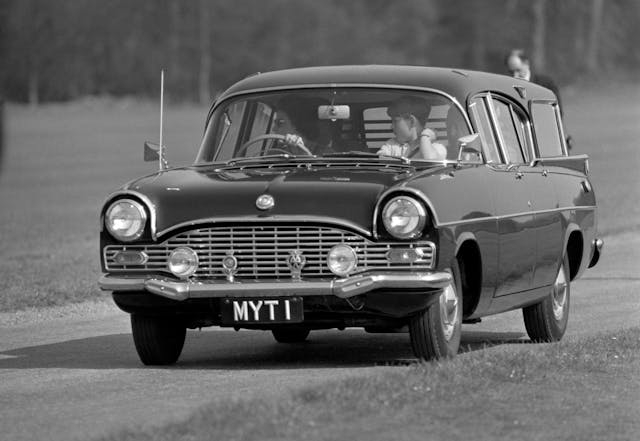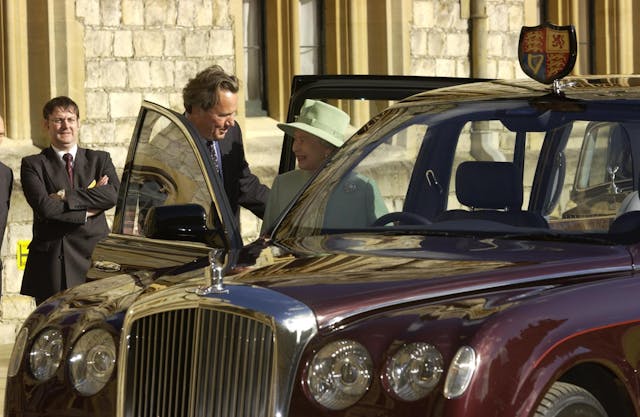The cars of Queen Elizabeth II
For a person who probably traveled more chauffeur-driven miles in her lifetime than anyone else on earth, the late Queen Elizabeth II had an uncommon urge to take the wheel herself.
Her views on the cars in her long motoring life are not recorded. There could never be anything so vulgar as an endorsement or a denigration. And anyway, Queen Elizabeth II was always happy to take the rough with the smooth, rattling along in the most rugged 4x4s or zipping about in leather-lined luxury.
The Range Rover in its successive iterations is the vehicle that seemed to suit her needs best. With three vast estates dotted about the country, the go-anywhere Rangie ticked every possible box: at times alive with Corgis, and at others with foreign royalty in the passenger seats (such as Saudi Arabia’s King Abdullah in 1998), open-mouthed as she romped through the Balmoral countryside, pointing out favorite beauty spots. Even David Cameron, one of the 15 assorted prime ministers who’ve come and gone during her long reign, was alarmed at the Queen’s “breakneck speed” as she showed him round, according to his autobiography For the Record.

It may come as a bit of a surprise, then, to recall that the Queen never took a driving test and didn’t possess a license. There was no need to. British driving licenses were ultimately issued in her name, so engaging in any DVLC paperwork would have been farcical. Nor does the monarch’s car need any number plates on the highway—another unique concession.
Princess Elizabeth entered the Second World War as a 13-year old girl and emerged from it as a proficient, 18-year old mechanic. Showing the quiet determination that would characterize her in later life, she insisted on doing her bit. To that end she was enrolled in 1944 in the British Army, in the Auxiliary Territorial Service. To the quiet admiration of her parents, she learned how to drive heavy army lorries and about what went on under the bonnet.
She could analyze and fix problems on recalcitrant engines, change wheels, assess roadworthiness and, of course, negotiate and reverse cumbersome Bedfords where even some men might have got jittery. No wonder, then, that the Queen was more than at home behind the wheels of the numerous Land Rover Series models and Defenders kept on Royal land.

The Women’s Auxiliary Air Force had a flick through The Autocar and chose a Daimler DE27 for the young princess and her fiancé as a wedding present in 1948. Daimlers were the marque of choice for the Royal Family in those days—they took delivery of 80 examples in total—and after her coronation in 1953 Elizabeth II would often drive her young children Charles and Anne around the Windsor area in a Hooper-bodied Regency Empress, when she wasn’t in the rear compartment of one of the larger Daimler limousines stabled at the Mews at Buckingham Palace.
Only after a tax scandal involving Daimler’s chairman did Royal patronage start to shift discreetly towards Rolls-Royce. The first was a Phantom IV in 1954, followed in 1961 by the latest Phantom V. This 3-ton behemoth really did travel the world with the Queen on her regular commonwealth tours and visits: It had its very own garage aboard the Royal Yacht Britannia, into which it could be eased once the bumpers were removed, and it was in active service right up to 2002 when the craft was decommissioned.
While the Queen could often be seen on the TV evening news waving from the back of various specially converted, open-topped ceremonial cars, when at home at Sandringham she preferred the use of a proper estate car. In a little-known car museum in a stable block at the Norfolk country seat, you can still see the specially designed Ford Zephyr MkII with its somewhat hearse-like contours that took the Queen, Prince Philip, and their guests on many a shooting party.

Unlikely as it seems, though, the Queen then switched allegiance to Vauxhall and seemed to revel in her PA and PC Cresta estates. The PA is still there at Sandringham, complete with its tongue-in-cheek number plate: MYT 1.
Her Majesty no doubt agreed with her husband that a car made an excellent 21st birthday present for their children. They gave Prince Charles an MGC, and Princess Anne a Reliant Scimitar GTE. For her own use in and around Windsor, however, the Queen was drawn towards Rovers. At first it was a P5 3-liter before moving to what is thought to have been one of her all-time favorites, a P5B 3.5 saloon.
When British Leyland rather thoughtlessly stopped making those, she moved over to Jaguars and Daimlers, apparently racking up 12,000 miles in one Daimler Double Six Series III that had a plump cushion in place of a back seat for those pampered, yappy Welsh dogs. Even as recently as earlier this year Queen Elizabeth was spotted in Windsor in a smart, green Jaguar X-Type estate, sporting her distinctive version of a racing helmet—a headscarf knotted under the chin.

It’s very likely that the Queen well understood what went into making great British cars. She was patron of the Royal Automobile Club where, on Thursday evening, car talk stopped and heads were bowed in silence on the announcement of her passing.
In 1956, she paid her first visit to a car factory with Prince Philip when they toured Jaguar’s bustling HQ in Coventry, and in 1957 she accepted the gift of a light blue Renault Dauphine on a visit to Renault’s British assembly plant in Acton, west London. In 2014 she opened Jaguar’s new engine plant in Wolverhampton.
Meanwhile, back in 2002, on the occasion of the golden jubilee of her reign, Queen Elizabeth was fully involved in creating the Bentley State limousine that would carry her on official duties for the next 20 years.

Her innate good taste came to bear in requesting the minimum of flashy external chrome and comfortable, rather than opulent, trim and upholstery, with soft cloth and not sticky leather, and wide-opening doors cut into the roof of the body, allowing her to stand fully upright when disembarking.
The color scheme chosen was black over Royal Claret paintwork with red coachlines, a livery originated in 1902 on the Daimler Tonneau of her grandfather Edward VII. Car traditions, like so many others, were very important to her.
On the other hand, British car innovations intrigued the Queen. Alec Issigonis was a friend of her brother-in-law Lord Snowdon and just after the revolutionary little runabout was launched, it’s said that Issigonis took a factory-fresh Mini to Windsor Great Park so that a certain rather keen driver could have a spirited turn at the wheel…
Check out the Hagerty Media homepage so you don’t miss a single story, or better yet, bookmark us.


